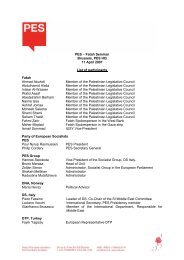Hedge funds and Private Equity - PES
Hedge funds and Private Equity - PES
Hedge funds and Private Equity - PES
You also want an ePaper? Increase the reach of your titles
YUMPU automatically turns print PDFs into web optimized ePapers that Google loves.
no correlation with market indexes, it goes without saying that they are suitable for portfolio diversification<br />
with few risks when they anticipate the narrowing of spreads. However as LTCM<br />
revealed, high returns on those strategies imply a large leverage <strong>and</strong> both legs of the investment<br />
are losing if spreads widen in disorderly market conditions. Even seemingly careful strategies<br />
might put HFs in jeopardy if they indulge in high leverage.<br />
But arbitrage strategies have always made a modest proportion of HF investments <strong>and</strong> this<br />
proportion is shrinking for both structural <strong>and</strong> cyclical reasons. Directional bets are dominant<br />
<strong>and</strong> deliver mediocre results in adverse macroeconomic conditions. Nonetheless hedge <strong>funds</strong><br />
developed massively after 2000 while rates of interests slipped downwards <strong>and</strong> equity markets<br />
plummeted. Institutional investors were looking for a dual strategy:<br />
A benchmarked passive portfolio to cover their costs<br />
An active management portfolio in the hope of boosting their overall return. To try to achieve<br />
their goal they invested both in <strong>funds</strong> of <strong>funds</strong> <strong>and</strong> in individual hedge <strong>funds</strong>. Controlling their<br />
active portfolios raises new problems of performance measurement (taking account of the<br />
probability of extreme losses) <strong>and</strong> risk assessment.<br />
It is quite plain that the opacity of hedge <strong>funds</strong> deprives institutional investors of any meaningful<br />
quantitative risk control.<br />
The more hedge <strong>funds</strong> rely on fathomless investment strategies that increase markedly in weight<br />
according to table 2 (specifically multi strategies <strong>and</strong> event-driven), the more their institutional<br />
clients have to rely on the good faith of fund managers. The only control institutional investors<br />
can engineer is upstream. They should develop networks of acquaintances to facilitate reference<br />
checking in order to get a thorough underst<strong>and</strong>ing of the would-be fund manager’s investment<br />
operations. It is awfully costly <strong>and</strong> time-consuming. Often pension fund trustees have neither the<br />
organisational resources nor the ability to run the investigation in-house. They must resort to<br />
counsellors biased towards getting more business for hedge <strong>funds</strong>.<br />
It should be commonsense that a reasonable policy of market transparency would improve the<br />
principal agent relationship inherent in delegated management.<br />
<strong>Hedge</strong> <strong>funds</strong> are going to manage more <strong>and</strong> more public money <strong>and</strong> a significant “retailisation”<br />
is under way. The call for some regulation will gain momentum. In the EU, as far as UCITS III<br />
allows mutual <strong>funds</strong> to indulge in hedge fund-type strategies, the need for a common regulation<br />
regime addressing hedge <strong>funds</strong> <strong>and</strong> their managers becomes pressing. Three motives for regulation<br />
are financial stability, investor protection <strong>and</strong> market integrity (against frauds, market abuse<br />
<strong>and</strong> money laundering).<br />
Financial regulation is most effective when it targets the conflicts of interest between market<br />
participants, risks, <strong>and</strong> stress points within the financial services supply chain. The supply chain<br />
for the hedge fund market is particularly complex when compared to the ‘traditional’ asset<br />
management industry because of the use of various counterparties (often unknown to the<br />
investor) <strong>and</strong> due to anomalies such as fund managers <strong>and</strong> actual <strong>funds</strong> being regulated in onshore<br />
<strong>and</strong> off-shore jurisdictions.<br />
The supply chain approach to regulation allows policymakers to identify the areas in the market<br />
which are most likely to give rise to detriment, recognise the different levels of sophistication of<br />
various market participants, <strong>and</strong> deploy targeted, proportionate regulatory interventions.<br />
Part III – Lessons to be drawn for future regulation<br />
161




